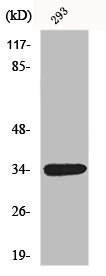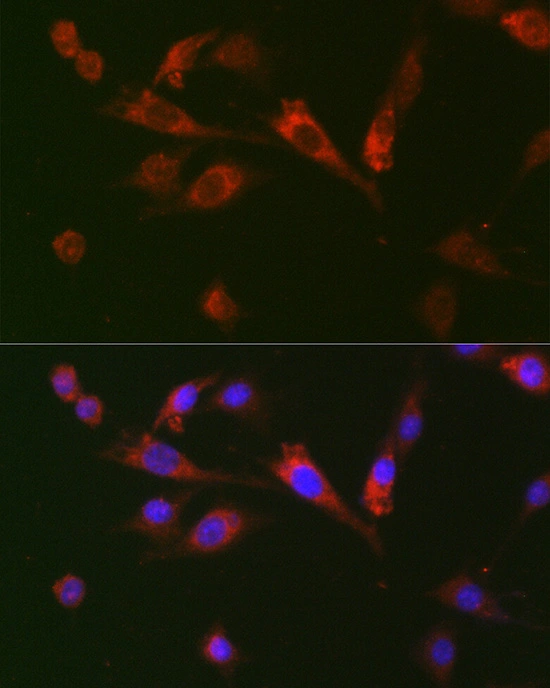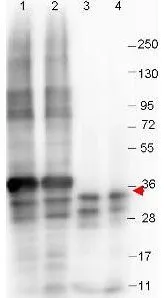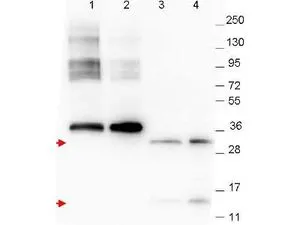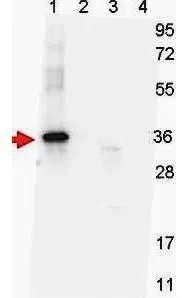
Western blot shows detection of recombinant NAG-1 protein present in Pichia pastoris whole cell lysates: lane 1 - yeast cell lysate expressing NAG-1 H variant with SUMO expression tag at 36 kDa; lane 2 - yeast cell lysate expressing NAG-1 D variant with SUMO expression tag at 36 kDa; lane 3 - yeast cell lysate expressing NAG-1 H variant; and lane 4 - yeast cell lysate expressing NAG-1 D variant. All lysates were run under reducing conditions. Primary antibody was used at a 1:1,000 dilution in TBS containing 1% BSA and 0.2% Tween, and reacted overnight at 4oC. For detection, a 1:40,000 dilution of peroxidase conjugated Goat-anti-Mouse IgG secondary antibody for 30 min at room temperature. Molecular weight estimation was made by comparison to prestained MW markers.
GDF15 (H Variant) antibody [7C12.B3.F2]
GTX48499
ApplicationsWestern Blot, ELISA
Product group Antibodies
TargetGDF15
Overview
- SupplierGeneTex
- Product NameGDF15 (H Variant) antibody [7C12.B3.F2]
- Delivery Days Customer9
- Application Supplier NoteWB: 1:1000. ELISA: 1:150000. *Optimal dilutions/concentrations should be determined by the researcher.Not tested in other applications.
- ApplicationsWestern Blot, ELISA
- CertificationResearch Use Only
- ClonalityMonoclonal
- Clone ID7C12.B3.F2
- Concentration1.3 mg/ml
- ConjugateUnconjugated
- Gene ID9518
- Target nameGDF15
- Target descriptiongrowth differentiation factor 15
- Target synonymsGDF-15, HG, MIC-1, MIC1, NAG-1, PDF, PLAB, PTGFB, growth/differentiation factor 15, NRG-1, NSAID (nonsteroidal anti-inflammatory drug)-activated protein 1, NSAID-activated gene 1 protein, NSAID-regulated gene 1 protein, PTGF-beta, macrophage inhibitory cytokine 1, non-steroidal anti-inflammatory drug-activated gene-1, placental TGF-beta, placental bone morphogenetic protein, prostate differentiation factor
- HostMouse
- IsotypeIgG2b
- Protein IDQ99988
- Protein NameGrowth/differentiation factor 15
- Scientific DescriptionNon-steroidal anti-inflammatory drug (NSAID) activated gene (NAG-1) is a member of the transforming growth factor-beta (TGF-beta) superfamily. NAG-1 is also known as Macrophage Inhibitory Cytokine-1 (MIC-1), Growth Differentiation Factor 15 (GDF15), Placental Bone Morphogenetic Protein (PLAB), or Prostate Derived Factor (PDF). NAG-1 is expressed in human placenta, prostate and colon. It possesses antitumorigenic and proapoptotic activities. NAG-1 expression is dramatically increased in inflammation, injury and malignancy. Increase of NAG-1 expression is a feature of many cancers including breast, colon, pancreas and prostate. In a number of studies, NAG-1 expression was increased by a number of NSAIDs. This increase in expression may correlate with the chemopreventive effect NSAIDs seem to have with certain cancers. NAG-1 expression is also induced by PPAR gamma ligands and by several dietary compounds such as conjugated linoleic acids (CLAs), naturally occurring fatty acids in ruminant food products, indoles, epicatechin gallate, and genistein. Induced expression of NAG-1 results in stimulation of apoptosis and inhibition of cell growth. Inhibition of NAG-1 induced expression by small interference RNA (siRNA) results in repression of induced apoptosis. NAG-1 expression is regulated by a numbers of transcription factors such as ERG-1 and Sp1. EGR-1 may be necessary for NSAID-induced NAG-1 expression. The study of expression of NAG-1 proteins, including variants, is important to define their potential role as serum biomarkers for cancer diagnosis, treatment monitoring, epidemiology study, and nutrition surveys.
- Storage Instruction-20°C or -80°C,2°C to 8°C
- UNSPSC12352203

![ELISA analysis of various samples using serially diluted GTX48499 GDF15 (H Variant) antibody [7C12.B3.F2]. Red : H variant Green : D variant Coating : 0.1 microg ELISA analysis of various samples using serially diluted GTX48499 GDF15 (H Variant) antibody [7C12.B3.F2]. Red : H variant Green : D variant Coating : 0.1 microg](https://www.genetex.com/upload/website/prouct_img/normal/GTX48499/GTX48499_20240423_ELISA_243_24042320_788.webp)
![WB analysis of various samples using GTX48499 GDF15 (H Variant) antibody [7C12.B3.F2]. Lane 1 : SUMO-tagged NAG-1 H variant Lane 2 : SUMO-tagged NAG-1 D variant Lane 3 : NAG-1 H variant Lane 4 : NAG-1 D variant Dilution : 1:1000 WB analysis of various samples using GTX48499 GDF15 (H Variant) antibody [7C12.B3.F2]. Lane 1 : SUMO-tagged NAG-1 H variant Lane 2 : SUMO-tagged NAG-1 D variant Lane 3 : NAG-1 H variant Lane 4 : NAG-1 D variant Dilution : 1:1000](https://www.genetex.com/upload/website/prouct_img/normal/GTX48499/GTX48499_20240423_WB_244_24042320_379.webp)
